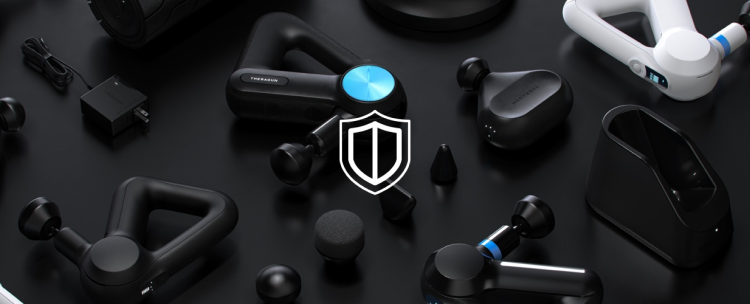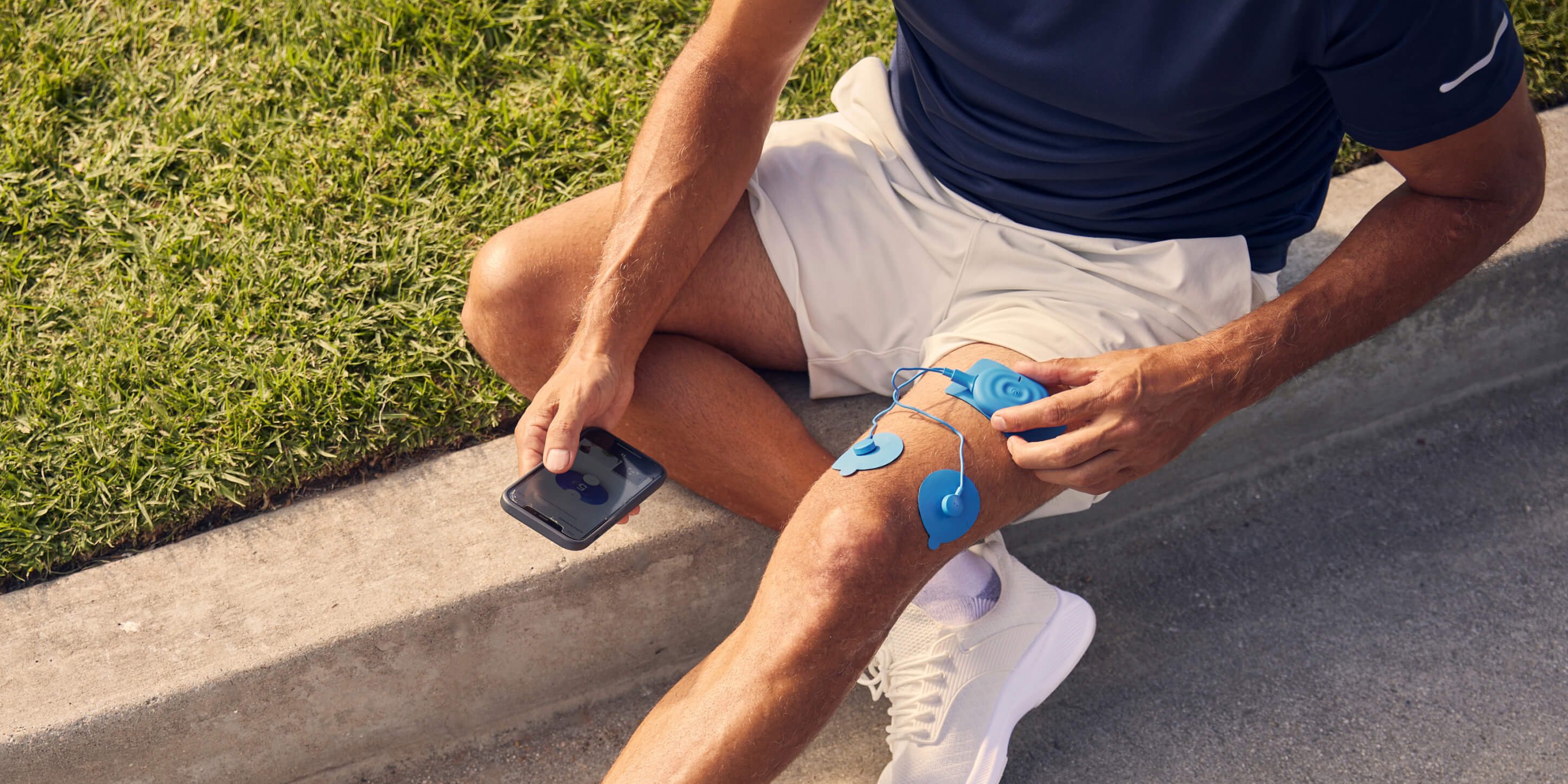Authors: Joshua Dexheimer, PhD; Therabody Scientists: Tim Roberts, MSc; Rachelle Reed, PhD, MS, ACSM-EP; Kyle Silvey, PhD, CSCS; Michelle Darian, MS, MPH, RD, LDN
Chronic pain affects an estimated 50 million Americans — over 20% of the adult population. For about 20 million of these individuals, the pain is severe enough to limit common daily activities or reduce quality of life. The data is clear: pain is significantly disrupting people’s lives. [1]
Low back pain is particularly prevalent, with approximately 80% of adults experiencing it at some point. Traditionally, available solutions for pain management included medications (both over-the-counter and prescribed) and taking a trip to the doctor. [2]
A promising at-home option is gaining traction: electrical stimulation. This therapy, now increasingly available for home use, may sound intimidating, but has centuries of history in pain treatment and strong supporting scientific evidence.
Recent research shows that electrical stimulation not only treats pain but can also improve athletic performance and recovery. [3, 4, 5]
So, what exactly is electrical stimulation, and how can you experience it at home? In this article, we’ll explore the science behind this therapy, its pain-relieving mechanisms, and its potential to enhance both performance and recovery.
What is Electrical Stimulation?
Electrical stimulation has a rich history dating back to ancient Egypt, where it was discovered that certain fish could emit electrical impulses capable of treating pain. [3] Electrical stimulation sends electrical signals through a device, stimulating sensory and/or motor nerves.
Today, two main types of electrical stimulation that have made their way into at-home devices: neuromuscular electrical stimulation (NMES) and transcutaneous electrical nerve stimulation (TENS).
While both NMES and TENS act on pain, they do so through different mechanisms. Here’s a simple way to think about it:
Let’s dive into the mechanisms behind both NMES and TENS in more detail.
How NMES Enhances Pain Relief
NMES is a therapy that offers pain relief by actively engaging muscles. The device delivers small electrical pulses, causing the muscle to contract and relax systematically. [4]
This therapy improves health through multiple mechanisms:
- Increase Blood Flow: NMES increases blood flow to the treatment area. It circulates nutrient-rich blood and removes waste products. This is particularly beneficial for warm-ups or post-workout recovery sessions. [6]
- Muscle Fiber Activation: NMES acts on muscle fibers to strengthen the connection between brain and muscle movements. In rehabilitation, it can help “re-educate" pained or weakened muscles. [7]
By combining these effects, NMES provides immediate relief and contributes to long-term muscle health and pain management.
How NMES Improves Performance and Recovery
NMES’s pain-relieving capabilities have led researchers to explore its potential for enhancing recovery and performance.
- Recovery: When electrical impulses are sent to your muscle fibers, they contract. These contractions increase blood flow and circulation, improving nutrient distribution and reducing muscle soreness — hallmarks of better recovery. [8, 9]
- Performance: NMES is utilized in prehab and rehab clinics, as well as in human performance centers, to improve muscle strength and expedite injury recovery. Its benefits extend beyond athletes; studies show that NMES can help maintain muscle mass in older populations, who are more susceptible to muscle loss. [10]
By benefiting both recovery and strength, NMES offers a comprehensive approach to enhancing all-around physical performance and maintaining muscle health across various populations.
How TENS Modulates Pain
TENS has been shown to modulate (meaning to modify) the amount of pain someone is experiencing. Two primary theories explain its mechanism:
- Gate Control Theory of Pain
Gate Control Theory suggests that a neural mechanism in the spinal cord acts as a gate. This gate can swing open or closed, opening up or shutting down the flow of signals from the body to the brain. TENS works by sending signals via sensory nerves to “close the gate," effectively blocking pain signals from reaching the brain. This modulates the amount of pain a person experiences. [5] - Endorphin Release
Endorphin Release suggests that TENS promotes the production of endorphins from the brain, the body’s “feel good hormones." Endorphins then block pain messages from reaching the body. Similar to a “runner’s high," these endorphins block pain signals from reaching nerve cells. By triggering endorphin release, TENS can make you feel better than before treatment. [5]
Studies on TENS for Pain Relief
Research demonstrates TENS’s effectiveness in various pain conditions. For instance:
- Studies show that TENS effectively improved low back pain after just 15 minutes of use. [11]
- A summary of data from 381 studies found moderate-certainty evidence that pain intensity is lower during or immediately after TENS compared with placebo. [12]
- TENS can alleviate primary dysmenorrhea symptoms, such as pain from menstrual cramps. [13]
Combining NMES and TENS for Pain Relief and Performance
While NMES and TENS are individually effective for pain relief, research shows combining these therapies can yield even greater benefits.
A 2020 randomized controlled trial investigated the effects of NMES, TENS, NMES + TENS, and a control therapy on knee pain and knee extension strength. Although all three therapy groups showed improvements, the NMES + TENS combination group demonstrated the most significant gains. [14] These findings are supported by an earlier study, which found that using NMES and TENS together resulted in greater pain reduction compared to TENS alone. [15]
NMES and TENS technology are backed by science to treat pain, offering a safe and effective treatment without using pain medications.
Recognizing the potential of this combined approach, Therabody’s PowerDot® integrates the benefits of both NMES and TENS into a single, user-friendly device.
By leveraging the unique mechanisms of both NMES and TENS, these combination therapies offer a comprehensive pain management, recovery, and performance enhancement approach.
Key Takeaways
- Electrical stimulation, including NMES and TENS, offers effective pain relief and performance enhancement.
- NMES stimulates muscle fibers, improves blood flow, and increases muscle strength.
- TENS modulates pain through the Gate Control Theory and by promoting endorphin release.
- Combining NMES and TENS can yield greater benefits than using each therapy alone.
- At-home devices like Therabody’s PowerDot offer both NMES and TENS functionalities in a single device.
References
- https://www.cdc.gov/mmwr/volumes/72/wr/mm7215a1.htm
- https://www.who.int/news-room/fact-sheets/detail/low-back-pain
- https://pubmed.ncbi.nlm.nih.gov/23249528/
- https://pubmed.ncbi.nlm.nih.gov/29162949/
- https://pubmed.ncbi.nlm.nih.gov/21483510/
- https://pubmed.ncbi.nlm.nih.gov/22477572/
- https://pubmed.ncbi.nlm.nih.gov/17174598/
- https://pubmed.ncbi.nlm.nih.gov/14524508/
- https://pubmed.ncbi.nlm.nih.gov/24785367/
- https://pubmed.ncbi.nlm.nih.gov/32610358/
- https://pubmed.ncbi.nlm.nih.gov/28379056/
- https://bmjopen.bmj.com/content/12/2/e051073
- https://pubmed.ncbi.nlm.nih.gov/32021488/
- https://academic.oup.com/milmed/article/185/7-8/e963/5816009
- https://pubmed.ncbi.nlm.nih.gov/9014958/







